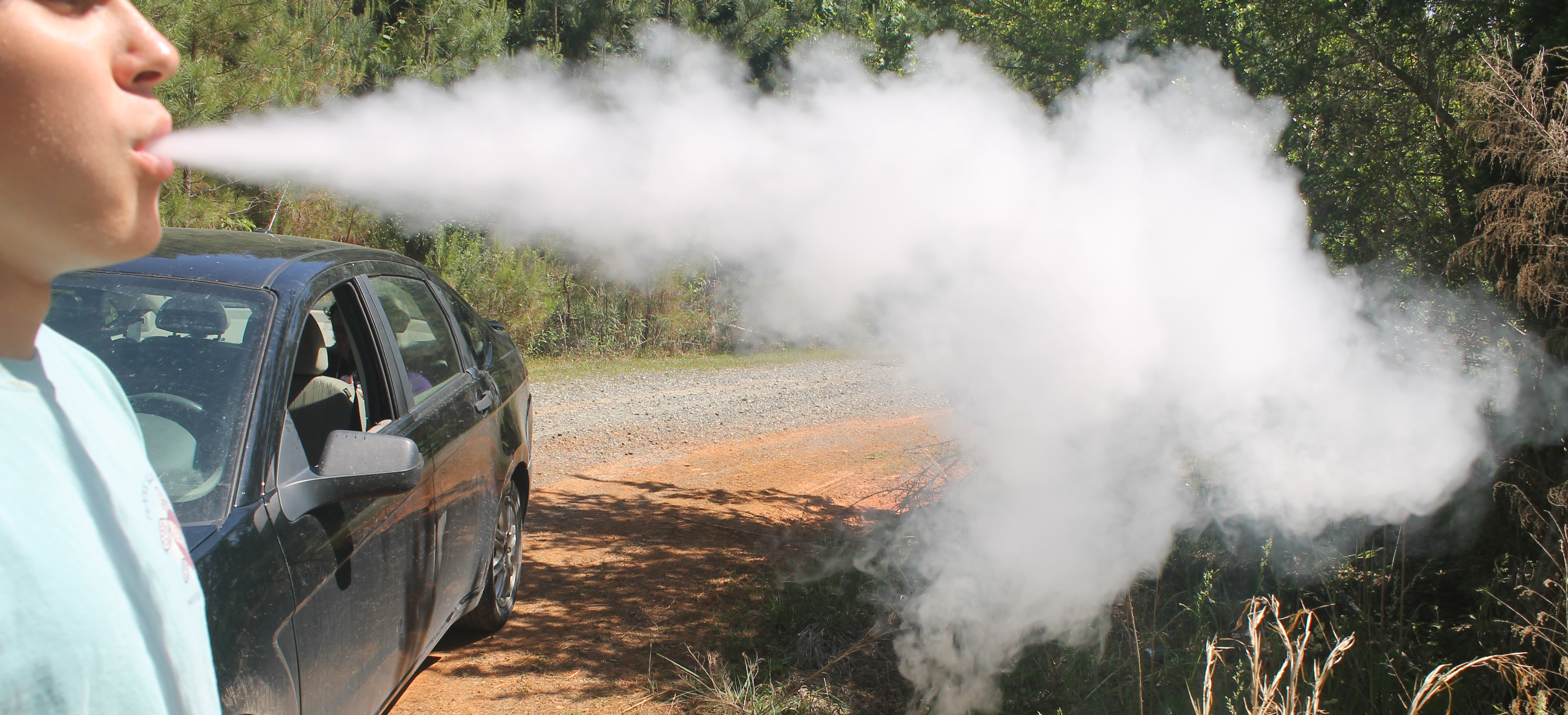“Nobody besides teachers and parents comment negatively about vaping; it’s just like a socially accepted thing at this point,” an anonymous junior said. “The older generation is against it because they don’t know enough about it and they associate it with the tobacco industry, which makes them think of cancer, but vaping has nothing to do with tobacco.”

Cigarettes, a tobacco product, have long plagued the lungs of Americans since 1865 when Washington Duke made the first hand rolled cigarettes, which were eventually made common across the U.S. in 1881 after James Bonsack invented the cigarette-making machine.
Now in 2015 we again find ourselves in the midst of another sort of “smoking revolution” that was born out of China in 2004, when the first disposable electronic cigarettes were internationally patented. “E-cigs” are a disposable direct cousin to “personal vaporizers,” or PVs, that can be reused. Most people refer to PVs as “vapes.” Both devices use a heating element to turn a mixture of propylene glycol or vegetable glycerin and nicotine into an inhalable vapor. In the last four years the number of teens who “vape” has increased from 2 percent to 13 percent, while the number of teens that smoke cigarettes has dropped from 16 percent to 9 percent according to the New York Times.
Purchasing vapes, e-cigarettes and all other smoke or tobacco products is illegal to those under 18 years old in 30 states, including North Carolina. There are still some states that have not put an age restriction on the purchasing of vapes and e-juice, but the FDA is currently working towards a law that will restrict buyers under 18 nationally.
While the jury may still be out on every effect it has on human wellness, experts agree across the board that the presence of nicotine, which is in both cigarettes and most “e-juice” (the liquid used in vapes), can be detrimental to one’s health. Dr. Thomas R. Frieden, the director of the C.D.C., told The New York Times that nicotine harms the developing brain. Nicotine is a highly addictive substance and is linked to most users’ interest in vaping.
“Once you get into it and you learn to inhale correctly, you definitely get a buzz if you use juice with nicotine,” said junior Kenny Baker, which is not his real name. “After a long day of school it can take the edge off. It’s just a desirable feeling.”
Some users vape solely for flavor and choose e-juice with little to no nicotine. These people often use vapes with larger batteries and modifiable coils which produce a much larger amount of vapor that are known as “mods.”
“The buzz you get from nicotine just makes my head feel bad and I don’t really like it,” an anonymous sophomore said. “I do like doing smoke tricks though, and it’s just fun to mess around with vapes, so I got a mod and I use zero-nic juice.”
The Vapor Girl, a popular chain of vape shops across the North Carolina, boasts having over 300 flavors of e-juice, which are available with nicotine levels ranging between 0 percent through 2.4 percent. With so much variety, it becomes even more difficult for doctors to pinpoint how usage may affect an individual because each user prefers a unique combination of equipment and e-juice.
According to another New York Times article, 4 to 7 percent of teens who use vapes say they have never smoked a tobacco cigarette. This statistic debunks the idea they are purely a new age device used to help people overcome a nicotine addiction and shows that some non- smoking teens have picked up vaping as a pastime with no tobacco-related motivation.
“The other side to vaping is it’s a pretty cool hobby to have,” Baker said. “You can completely customize your vape to improve its overall performance or to tweak it to satisfy your preferences. You can buy a ton of different tanks, coils and batteries, which all have different types of technology and different advantages, and of course there’s tons of different flavors to pick from when it comes to juice.”
Northwood’s School Resource Officer Herbie Stubbs has noticed vaping become increasingly popular.
“This year [vapes] have become very popular amongst the students,” Stubbs said. “They use them because they’re less conspicuous: you don’t really smell it like you can smell a cigarette.”
Northwood categorizes vapes as tobacco products and follows the tobacco policy when dealing with offenders. The first time a student is caught with a vape on campus, the device is confiscated and the student is given one day of ASD. In response to the second offense, the device is confiscated and that student receives three days of OSS. Assistant Principal Philip Little also noted that students caught in the act of vaping on a bus or in a classroom receive “more severe consequences because they disrupt student activities” in those environments.
There have been multiple incidents where students have been caught vaping on campus in bathrooms and even in classrooms.
“It’s actually caused distractions in classroom settings where kids will use them and disrupt the class,” Stubbs said. “I think they really just do that to show off and to see if they can get away with it.”
Combatting the new trend has been a busy task for Stubbs and the administration to keep up with.
“Cracking down on the [vaping] issue has been a roller coaster this year,” Stubbs said. “We started out taking a lot of them from students, and then it seemed to slow down a little bit, but in the last few weeks it’s picked back up. Today, April 28, I took one this morning, and that thing probably cost $200. The kid was [vaping] in their vehicle and I saw all the smoke in the windows and had to go take it.”
– By John Dunning



